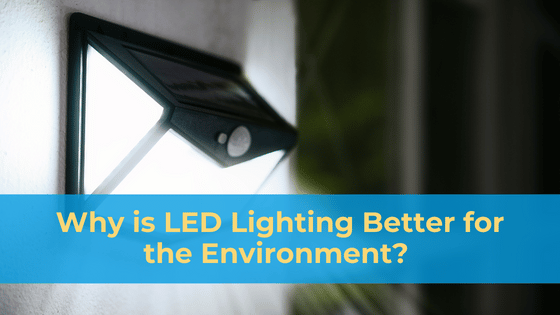
As technology advances, one of the benefits that comes along with it is reduced environmental impact. This is also true of LED lighting, which offers several positive environmental impacts on top of reduced operating costs.
LED’s green-friendly engineering is a primary reason why it’s a top choice for street lighting, parking lot lighting, sports field lighting, and many other large-scale applications. Here, we’ll take a closer look at what gives the technology its green reputation.
LED Lights Offer Unmatched Energy Efficiency and Minimal Heat Loss
The engineering behind LED lighting is far more sophisticated than that offered by legacy solutions. LED fixtures are driven by efficient semiconductor dies, which generate illumination by exchanging electrons at the atomic level. Compared to heated filaments or pressurized gas chambers, much less energy (in the form of heat) is lost with semiconductors.
At the lamp-level, this means LEDs spend more of their energy on light. LEDs convert 80 to 90 percent of the energy they receive into illumination. Compare this to metal halides, which only convert about 25 percent of received power into light.
At the source and system level, LED lighting consumes far less energy per watt than all other alternatives. That added energy efficiency is good for the environment, good for society and good for your company’s budget.
LED’s reduced heat radiation also reduces the load on HVAC systems, which is a downstream boost in energy efficiency.
LED Fixtures Prevent Excess Light Pollution
Light pollution may not harm air quality or build up on roadsides, but it can affect human and animal health all the same. Excess nighttime uplighting can produce ecosystem-destabilizing effects, such as altering migratory patterns or confusing nocturnal animals.
Too much nighttime illumination also has deleterious effects on people. It can disrupt sleep-wake cycles, exacerbating sleep disorders, and depression and anxiety. It can also result in fatigue, brain fog and various mood-related issues.
Engineers have been hard at work on the problem and some LED fixtures represent a viable solution. For example, shielded LED fixtures are designed to only emit illumination below the horizontal, and emit reduced output at angles close to the horizontal. Further, these fixtures are built with anti-glare optics, so they reflect less illumination up into the sky.
Another advantage of LED lighting is its controllability, and this controllability also makes LED fixtures an environmentally friendly option. With advanced controls, LED bulbs can be automatically dimmed when no one is nearby, reducing energy consumption. And this may be welcome in residential areas, where lighting trespass can be a significant nuisance.
LED Lamps Last Longer and Don’t Require a Secondary Disposal Stream
Compared to legacy lighting, LED fixtures last far longer. An LED bulb will provide around 50,000 hours of quality illumination before replacement is indicated, which means years of reliable operation between bulbs.
Fluorescent tubes provide between 8,000 and 15,000 hours of light, while metal halides are around the same (maybe a little less). That means you’ll replace a fluorescent tube or metal halide fixture up to six times before a single LED lamp replacement is required.
Reduced lamp turnover minimizes your facility’s operating costs, and it also minimizes material waste. Even better, LED fixtures do not need a dedicated waste disposal stream for safety reasons. That’s because LED light bulbs contain no mercury, which is a highly toxic substance. Mercury, though, is built into some of the components inside fluorescent lighting. When fluorescent lights break, it’s a safety hazard that will disrupt facility operations. LEDs aren’t hazardous in the same way, so they can be disposed of in your company’s general waste stream.
LED Fixtures Have a Lower Carbon Footprint
From manufacturing to disposal, LED lighting comes with a much smaller carbon footprint, compared to legacy lights. According to data tracked by the Office of Energy Efficiency and Renewable Energy, an incandescent bulb is responsible for 4,500 pounds of carbon dioxide every year, while an LED bulb is responsible for only 450 pounds of carbon dioxide emissions every year – a 90 percent reduction. An EPA study found that if every residential property replaced a single incandescent bulb with an LED bulb, it would reduce carbon emissions by more than 9 billion pounds every year.
And that’s just residential properties. At the commercial, industrial, and municipal levels, switching out legacy systems with LEDs will greatly shrink your company’s carbon footprint.
LED Lighting is More Effective When Used with Photometric Analysis
In many cases, companies must decide between environmental compliance and cost. It can be a difficult balance to strike, but with LED lighting, the cost and environmental benefits line up. With their excellent energy efficiency, extended lifespan and modern fixtures designs, LED lights are the first option for cities and businesses looking to go green.
And with their impressive ROI, reliability and illumination quality, LED lighting is also a top choice for companies that just want to save on the margins.
In either case, organizations can get the most out of their new LED lighting solution by working with an experienced system designer and installer. An experienced designer, for example, can perform a photometric analysis of your project. Photometric designs use a 3D model of the property to simulate various lighting solutions. The goal is to produce the most illumination possible with the fewest fixtures possible, taking care to avoid lighting trespass.
If an Organization Prioritizes Sustainability and Green Initiatives, LED Technology is the Ideal Lighting Solution
With their cost-saving and green-friendly benefits, companies are quickly making the shift to LEDs. If your organization is also considering the same, there are retrofit fixtures that will provide most of the benefits of a new LED lighting system at a lower cost. With multiple price points available and electricity costs on the rise, it’s an opportune time to make the transition.






